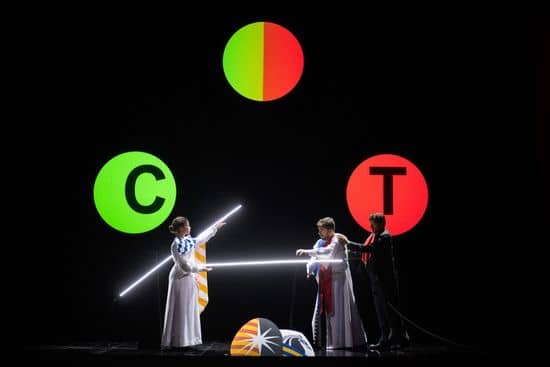Combattimento, La Théorie du Cygne noir
Directed by Silvia Costa
Creation for the Festival d’Aix-en-Provence 2021
In 1640, a few years before his death, Monteverdi published a testamentary collection. His eighth book of madrigals contains the essence of his art, blending the science he received from his Renaissance masters with all the innovations he brought to music, bringing the wonderful poetry of Tasso into the midst of new harmonies.
After his first Orfeo in 1607, Monteverdi perfected the opera, became the undisputed master of the madrigal, and his motets are the glory of the Basilica of San Marco in Venice, but in the middle of this collection he published an unclassifiable work. Le Combat de Tancrède et Clorinde (The Battle of Tancreda and Clorinda) is situated on a thread between opera, declamation, fable and chanson de geste. If this work had preceded his operas, it would have been considered a formidable laboratory of the lyric genre. But it dates from 1624: it is therefore the continuation, the pursuit of the reflections of a composer always on the lookout, always in ebullition, who produces this work as the search for an essence even more concentrated than the opera, of a way of telling a story in music that upsets his audience more deeply. For him, this Combattimento is a theatrical and lyrical work of a new kind, totally unprecedented. He reports that it moved the audience to tears. Thus, more than ten years after its composition, the work still holds such an important place in the heart of its author that he chose to integrate it into the eighth book of madrigals to pass on its memory.
The entire musical program of the show stems from this Combattimento: the repertoire comes from the decade that follows, through pages that founded the fame of this style, but also through rarities. These years 1640 are of a rare intensity in the history of music: all the talent of Monteverdi blooms there in his last works but also through all those whom he inspired, starting with the Roman Luigi Rossi, and his successor at San Marco, Francesco Cavalli. They are the heirs of a master, who knew their music in his lifetime. All these composers were born in the music of this new era, it is natural to them and flows under their pen like a mother tongue.
Monteverdi’s genius had the effect of a short circuit in the history of Western music, taking it to a place where no one could have imagined: this is the black swan theory. From the polyphonies of the Renaissance, from the superb counterpoints of religious music, from a certain hieraticism, Monteverdi passed into a new era. The visions of this artist, surrounded by a community of thinkers and aesthetes who certainly allowed him to give birth to them, brought the wind of emotions, of theater, of a more visceral expression of passions. The musical language has been totally changed: the singer, once one among others, has become a reciter at the center of attention, and the musicians who surround him are now there to carry, amplify and make his speech resonate.
This Combattimento, beyond the beauty of its music and the intensity of its theater, is in retrospect a manifest work of this new world: the story takes precedence over everything else, embodied by a Testo who holds the heart of the narrative, instruments that deploy a whole accompaniment at its service inaugurating new inventions such as the impressive stile concitato – unheard of virtuosity symbolizing agitation, iron and combat. If one projects oneself into the musical world in which Europe was evolving at that time, this manifesto work cuts through, completely bypasses history and takes it in a different direction. It is on these steps that the great musical inventors of the century will appear.
